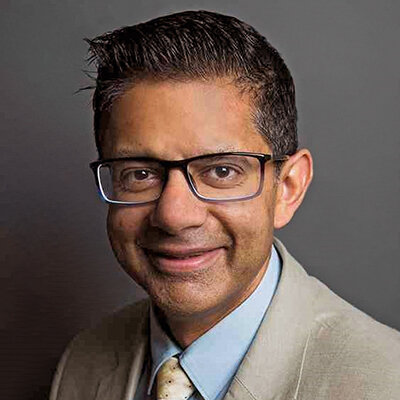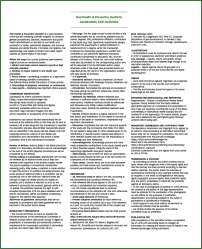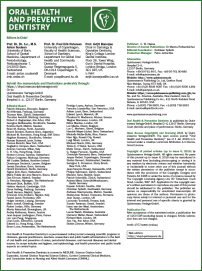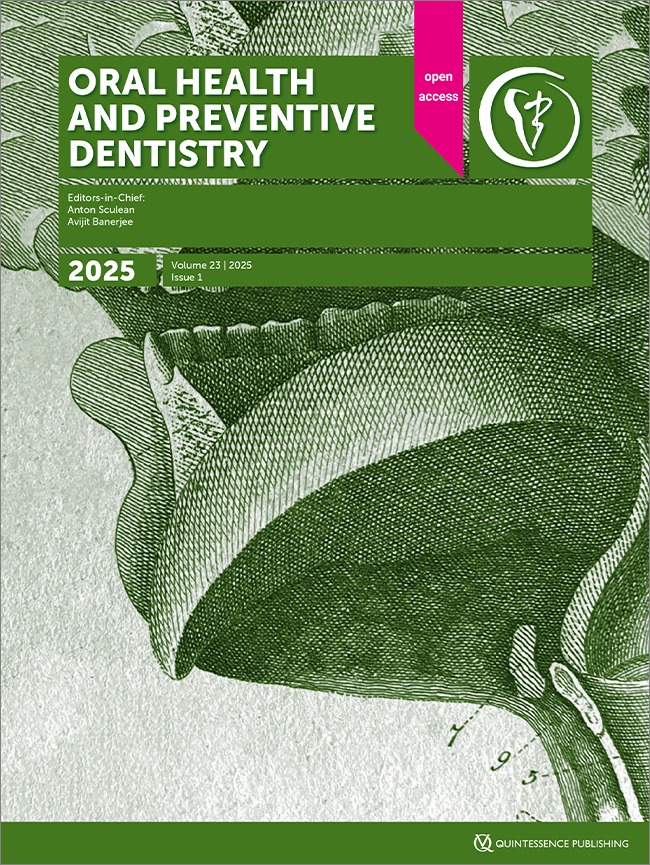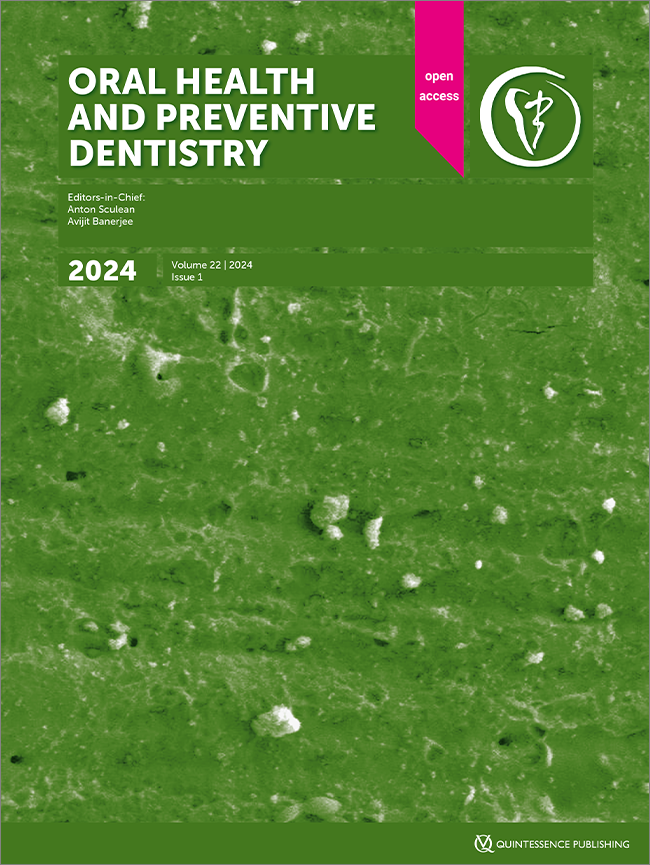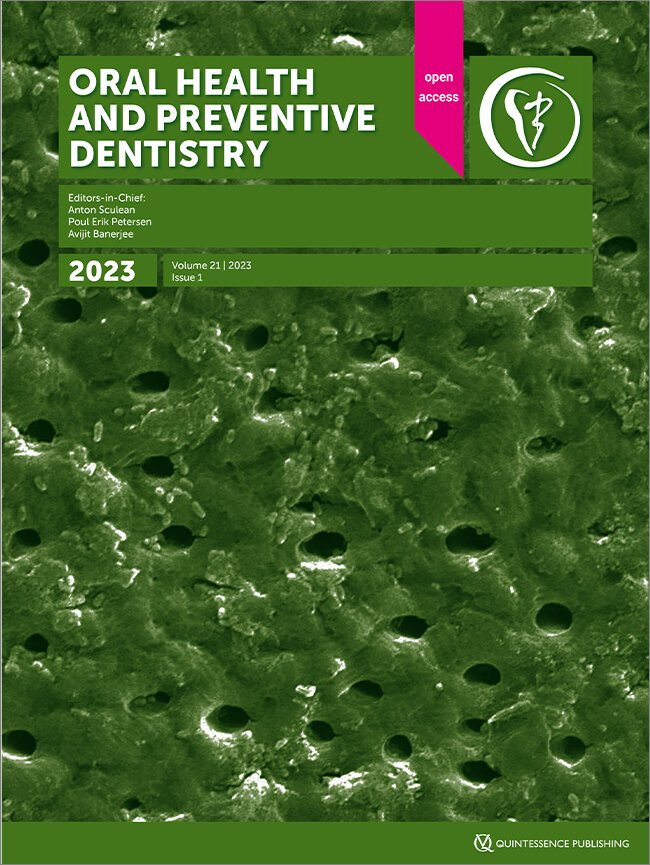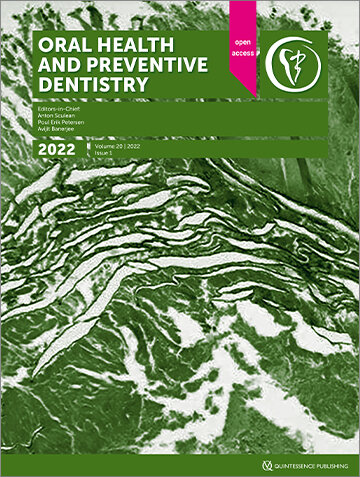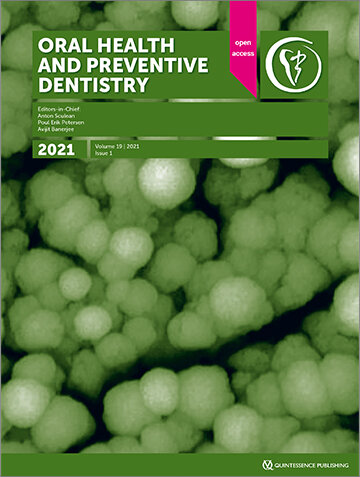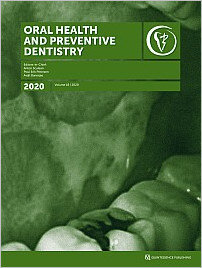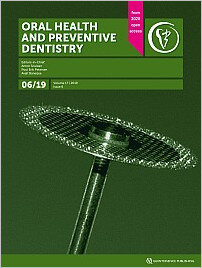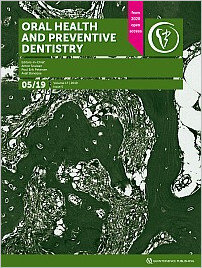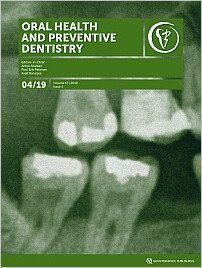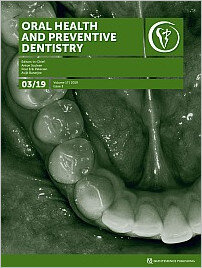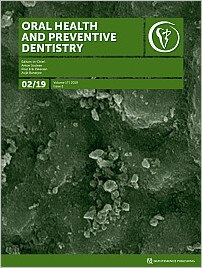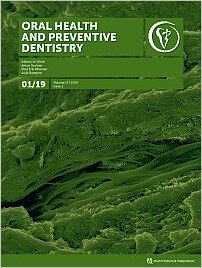Open Access Online OnlyOral HealthDOI: 10.3290/j.ohpd.c_1800, PubMed ID (PMID): 397745218. Jan 2025,Pages 1-20, Language: EnglishStaehle, Hans Jörg / Sekundo, CarolinePurpose: To trace the history of interdental brushes (IDBs) from their origins to the present, highlighting their development and future prospects compared to other interdental hygiene aids. Methods and Materials: A literature search using digital databases, manual reviews and on-site research in museums were carried out. Results: Although extensive literature exists on toothbrushes, flosses and toothpicks, there has been no comprehensive study of IDBs. Twisted brushes for oral hygiene were mentioned as ear-ly as the late 19th century. The exact origins of their use in interdental spaces remain unclear, but evidence narrows it to the early 20th century. IDBs have been in documented use since at least 1960, with publications emerging in the 1970s. Historically, evaluations of IDBs have been mixed, balancing high expectations with scepticism regarding efficacy and safety. By the early 21st century, IDBs were often considered superior for interdental cleaning. Advances included modifications in brush head designs, handle types, and the establishment of standards like ISO 16409, though these did not always facilitate proper selection and use. Conclusion: Recent literature still highlights limited evidence-based statements on IDB efficacy, with some questioning their superiority over other aids like dental floss. Consumer-friendly alternatives, such as rubber picks, are sometimes rated higher, however, without allowing for a final assessment. For IDBs to meet the standards of Frugal Dentistry, they must improve oral health, be widely demanded, and cost-effective. Future research should provide more precise indications for IDBs and scientifically sound recommendations for various sizes and designs, ensuring they are easy to use and effective for different interdental spaces.
Keywords: historical milestones of interdental brushes, interdental cleaning, developments in interdental brushes, future indications for interdental brushes
Open Access Online OnlyOrthodonticsDOI: 10.3290/j.ohpd.c_1801, PubMed ID (PMID): 397745228. Jan 2025,Pages 21-26, Language: EnglishYu, Zhuqing / Shen, XiaotengPurpose: To examine the alterations in oral healthcare indicators subsequent to the administration of cetylpyridinium chloride. Materials and Methods: In this retrospective study, clinical data of 58 patients who received orthodontic treatment using removable appliances at our medical facility were collected. Patients were divided into two groups based on whether they used cetylpyridinium chloride during orthodontic treatment: the combined group (n = 31, received 0.1% cetylpyridinium chloride gargle in addition to periodontal cleaning during the use of orthodontic appliances, with gargling applied three times daily for at least 1 min after meals) and the cleaning group (n = 27, received only periodontal cleaning). Data on oral healthcare were collected and analysed at 1, 3, and 6 months into the treatment regimen. The indices evaluated were gingival index (GI), sulcus bleeding index (SBI), probing depth (PD), and plaque index (PLI). Results: Subsequent evaluations revealed that, at 3 and 6 months post-intervention, patients in the intervention group exhibited statistically lower scores in GI, SBI, and PLI when compared to the control group. Similarly, the PD measurements showed more statistically significant reductions at each follow-up interval — 1, 3, and 6 months — in the intervention group. IL-10 levels were notably higher in the intervention group at 6 months. Conclusion: Integrating cetylpyridinium chloride into the oral healthcare regimen for patients using removable orthodontic appliances has been shown to statistically significantly improve oral health, enhance periodontal functions, and reduce inflammatory responses in the gingival sulcus.
Keywords: cetylpyridinium chloride, inflammatory cytokines, oral healthcare, removable orthodontic appliance
Open Access Online OnlyOral HealthDOI: 10.3290/j.ohpd.c_1804, PubMed ID (PMID): 397839549. Jan 2025,Pages 27-34, Language: EnglishÖzbey İpek, Hilal / Bolaca, ArifPurpose: Although fluoride is known to be effective and safe, an increasing number of parents refuse to allow fluoride applications for their children. This study aimed to compare the parents who accepted and rejected fluoride application for their children in terms of their attitudes toward fluoride and vaccinations, sociodemographic characteristics, and source of knowledge. Materials and Methods: In this cross-sectional study, a previously validated questionnaire was administered to 85 parents who did not consent to have topical fluoride applied to their children’s teeth (AF group) and the 143 parents who consented to have it applied (F group) in a pediatric dentistry clinic. Data were analysed using the independent t-test and chi-squared test. Results: In the F group, the number of those who disagreed with the statement that fluoride causes intellectual disability, autism, and damages the pineal gland was statistically significantly higher than in the AF group (p 0.05). The most common source of information for the AF group was the internet/social media (67.06%), while for the F group, it was dentists/medical doctors (62.24%). More parents in the F group stated that childhood and Covid-19 vaccinations must be performed; this was a statistically significant difference (p 0.05). Conclusion: No relationship was found between fluoride hesitancy and the educational level of the parents. Most parents in the AF group have doubts and concerns about fluoride rather than being strongly opposed to it. Therefore, educational programs given to parents are likely to have a positive effect on their acquisition of correct information.
Open Access Online OnlyOral HealthDOI: 10.3290/j.ohpd.c_1812, PubMed ID (PMID): 3981251215. Jan 2025,Pages 35-42, Language: EnglishAl Harthi, ShaimaaPurpose: Health education programmes play a crucial role in enhancing oral health literacy and improving treatment out-comes. However, myths and misconceptions about oral health are widespread, affecting individuals’ behaviours and their willingness to seek appropriate treatment. This study aimed to investigate the prevalence of oral health myths and miscon-ceptions among adults in Taif, Saudi Arabia, and to explore potential associations with demographic factors. Materials and Methods: Participants from community health programmes in Taif (March–June 2024) completed a Google Forms questionnaire on dental myths. Eligibility criteria: adults (≥18 years) without cognitive, hearing, or vision impairments. The questionnaire included sociodemographic details and 22 myth-related questions. Data analysis involved descriptive statistics and multiple linear regression using the Statistical Package for Social Sciences (SPSS), with significance set P ≤ 0.05. Results: The study included 429 participants. Knowledge of dental myths was highest in the ‘Dental Treatment’ domain (mean score: 6.42), followed by ‘Oral Hygiene Practices’ (3.46) and ‘Deciduous Teeth and Pregnancy’ (3.48). Higher education and healthcare-related majors were statistically significantly associated with better knowledge. Conversely, males and older age groups had lower knowledge scores. Conclusion: This study highlights the prevalence of dental myths in Taif and their association with demographic factors. Higher education- and healthcare-related fields correlate with better knowledge, but statistically significantly gaps remain, particu-larly among the less educated, certain occupational groups, males, and single individuals. Targeted educational interventions are essential to improving dental health knowledge and practices and enhancing oral health outcomes in the community.
Keywords: demographic factors, health education, myths and misconceptions, oral health
Open Access Online OnlyPeriodontologyDOI: 10.3290/j.ohpd.c_1805, PubMed ID (PMID): 3984083422. Jan 2025,Pages 43-49, Language: EnglishCiurescu, Codruta Elena / Dima, Lorena / Gheorghiu, Anca / Ciurescu, Vlad Alexandru / Festila, Dana Gabriela / Moga, Marius Alexandru / Vesa, Stefan / Cosgarea, RalucaPurpose: The purpose of this study was to evaluate the occurrence of peri-implant diseases and their potential risk indicators in a private practice setting. Materials and Methods: This cross-sectional study evaluated data from 390 subjects (mean age 55.8 ± 11.6 years) with implant-supported prosthetic reconstructions, who were enrolled in a maintenance program for 6.25 ± 3.36 years. Clinical evaluation included peri-implant probing pocket depth (PPD), bleeding on probing (BOP) and full-mouth plaque scores (FMPS). Radiographic evaluation was performed using retro-alveolar radiographs for each implant. Further, smoking habits, history of periodontitis, or tooth loss due to periodontal disease, presence/absence of keratinized mucosa ≥ 2 mm and the quality of the prosthetic restoration were also assessed. The prevalence of the peri-implant disease (at the subject/implant level) was determined and various potential risk indicators were evaluated by multi-level logistic regression analysis. Results: The prevalence of peri-implant diseases was 37.7% and 23.3% at the subject and implant level, respectively. 14.3% of the subjects were diagnosed with peri-implant mucositis and 8.9% were diagnosed with advanced peri-implantitis (PI). PI was statistically significantly associated with poor (FMPS > 0.45, p 0.001) or moderate oral hygiene (FMPS: 0.3–0.45, p 0.001), a history of periodontitis (p 0.001), lack of keratinized tissue ≥2 mm (p 0.001) or implant function time > 5 years (p 0.001). Conclusion: In a private practice setting, a prevalence of peri-implant diseases of 37.7%/ 23.3% (subject/implant level) was found. Poor oral hygiene, history of periodontitis, a keratinized mucosa 2 mm and a time in function ≥ 5 years have been associated with the occurrence of peri-implant diseases.
Open Access Online OnlyOral MedicineDOI: 10.3290/j.ohpd.c_1817, PubMed ID (PMID): 3984083522. Jan 2025,Pages 51-58, Language: EnglishAlqarni, Hatem / Qadoumi, Majd / AlShehri, Nouf / AlNowaiser, Norah / Alaqeely, Razan / AlHelal, Abdulaziz A. / Alrabiah, Mohammed / Alshihri, Abdulmonem / Alsayed, HussainPurpose: This in-vitro study was conducted to assess the fracture resistance of resin-bonded ceramic endocrowns with different designs at varying intracoronal depths. Materials and Methods: Forty-eight (n = 48) extracted mandibular first molar teeth were randomly divided into four groups (n = 12). In the control group, the specimens remained untreated. Whereas the specimens in the test groups A, B, and C were decapitated 2 mm above the cementoenamel junction (CEJ) and endodontically treated. The test groups were prepared with a butt-joint design in a standardised manner with varying intracoronal depths. Groups A, B, and C were prepared to receive lithium disilicate endocrown with intracoronal cores at 0 mm, 2 mm, and 4 mm, respectively. Crowns were fabricated as a non-anatomical design with a thickness of 3 mm. After ceramic bonding procedures, specimens underwent thermocyclic ageing prior to the fracture resistance test. Specimens were loaded at a 15-degree angle using the Universal Testing Machine and the failure modes were observed. One-way analysis of variance (ANOVA) and Chi-square were utilised for data statistical analyses. Results: Significant statistical results in fracture resistance tests were found in all experimental groups. The highest load was found in group B, followed by group C, and lastly group A (P 0.05). Although endocrowns with no extension had the lowest fracture resistance, they showed a favourable cohesive failure with statistically no significant difference from the control group. Conclusion: In bonded ceramic endocrowns, the fracture resistance is not newcessarily proportional to the intracanal depth. The intrcoronal cores of 4 mm did not show the highest fracture resistance, and their mode of failure was catastrophic compared to endocrowns with no intracoronal extensions.
Keywords: endocrown, fracture, intracoronal depth, resistance
Open Access Online OnlyCariologyDOI: 10.3290/j.ohpd.c_1811, PubMed ID (PMID): 3984696723. Jan 2025,Pages 59-66, Language: EnglishMa, Yan / Chen, Haoran / He, Yan / Tao, LimingPurpose: To compare remineralisation efficacy between silver diamine fluoride (SDF) combined with potassium iodide (KI) and sodium fluoride (NaF) varnish using hydroxyapatite (HAP) artificial white spot lesions (AWSLs) demineralisation model. Materials and Methods: A total of 25 HAP disks was randomly divided into five groups (n = 5): baseline, AWSLs, deionized water (DW), SDF-KI or F-varnish. After AWSLs were developed, the specimen was treated with either deionized water, SDF-KI or F-varnish. These specimens were then subjected to pH-cycling for 7 days. The remineralisation potential was assessed by measuring changes in Vickers hardness (VHN). Morphological and compositional analyses were conducted using scanning electron microscopy (SEM), energy dispersive x-ray (EDX), x-ray diffraction (XRD), and Fourier-transform infrared spectroscopy (FTIR). Ion-selective electrodes (ISE) were utilised to measure calcium and fluoride release. Results: SDF-KI treatment demonstrated statistically significant remineralisation potential in restoring VHN values vs baseline levels (p 0.001). SEM, EDX, and XRD analyses confirmed the mineral deposits to indicate remineralisation. The uptake of calcium was higher in SDF-KI than in F-varnish (p = 0.011). The fluorapatite (FAP) and fluoride-substituted apatite formation were validated by FTIR and XRD analyses.Conclusion: SDF-KI and F-varnish applications are both effective in promoting remineralisation on HAP disks. The application of SDF-KI affected the physicochemical and mechanical properties of demineralised HAP. The SDF-KI showed more formation of fluoride-substituted apatite and is effective in the hardening of demineralised HAP.
Keywords: demineralisation, potassium iodide, remineralisation, silver diamine fluoride, sodium fluoride
Open Access Online OnlyOral HealthDOI: 10.3290/j.ohpd.c_1794, PubMed ID (PMID): 3984696823. Jan 2025,Pages 67-75, Language: EnglishBorg-Bartolo, Roberta / Roccuzzo, Andrea / Tennert, Christian / Prasinou, Maria / Jäggi, Maurus / Molinero-Mourelle, Pedro / Schimmel, Martin / Bornstein, Michael M. / Campus, GuglielmoPurpose: To evaluate the oral health status of community-dwellers ≥ 45 years of age in the canton of Bern, Switzerland. Materials and Methods: Data were collected using a questionnaire (including sociodemographic factors, medical history, oral health behaviour) and a clinical examination comprising caries, periodontal disease, oral hygiene, and prosthetic rehabilitation. χ2/Fisher’s tests and Cochrane Armitage trend tests as well as a binary logistic regression were performed to assess the association between oral disease presence (i.e., periodontal disease [PSI (periodontal screening index) score 3-4] and/or active dental caries [ICDAS 4-6, root ICDAS 2]) and the independent variables. Results: A total of 275 participants were included in the present study: 154 (56%) males and 121 (44%) females, with a mean age of 69.7 years (SD 11.6). The majority presented with good oral health behaviour; 221 (86%) brushed their teeth at least twice daily, 196 (79%) had regular dental visits. Nevertheless, 82 (32%) participants presented with an approximal plaque index of > 50%. The older age groups and participants with bleeding gums had higher odds of having active dental caries and/or periodontal disease (65-74 years – OR 2.88 [95% CI 1.33–6.25], ≥75 years – OR 2.60 [95% CI 1.17–5.78], bleeding gums OR 3.52 [95% CI 1.07–11.50]). Conclusion: The present study shows an association between age, oral hygiene, and the presence of active caries and periodontal disease. The study highlights the importance of good oral hygiene maintenance, especially in older adults.
Keywords: epidemiology, dental caries, oral health status, periodontal disease, public health
Open Access Online OnlyCariologyDOI: 10.3290/j.ohpd.c_1816, PubMed ID (PMID): 3984696923. Jan 2025,Pages 77-82, Language: EnglishHristov, Krasimir Mitkov / Angelova, Liliya Marinova / Georgieva, Nedana Emilova / Bogovska-Gigova, Ralitsa TodorovaPurpose: To make micro-CT comparison and evaluation of sealant penetration depth in different types of fissures after heating of the material or application of vibrations. Materials and Methods: One hundred sound third molars have been sealed as follows: group 1 (n = 20), light-cured resin sealant at room temperature, group 2 (n = 20), light-cured resin sealant, preheated to 41.0°C, group 3 (n = 20), light-cured resin sealant, preheated to 51.0°C, group 4 (n = 20), resin sealant with application of vibrations before light-curing at room temperature, group 5 (n = 20), resin-modified glass-ionomer cement. The samples were analysed using micro-computed tomography (micro-CT). The profile of each fissure was classified, and the penetration depth of the sealant into the fissure and the fissure depth were measured. The ratio of filled area and total depth of the fissure was calculated in percentages. Results: Pre-heating of the sealants and the usage of a vibrating tool improved the penetration depth compared to the application of the material at room temperature. U- and V-type fissures exhibited better penetration capability than others. For IK-type fissures, the best penetration was observed with resin sealant heated at 51.0°C. I-shaped fissures exhibited lower penetration rates despite the heating process. Glass-ionomer cement showed the least depth penetration. Conclusion: Pre-heating of the resin sealant or application of vibrations improve statistically significantly penetration in the different fissure types.
Keywords: caries prevention, sealant penetration, pits and fissures, sonic vibration, heat
Open Access Online OnlyOral HealthDOI: 10.3290/j.ohpd.c_1827, PubMed ID (PMID): 3984697023. Jan 2025,Pages 83-91, Language: EnglishNaik, Sachin / Vellappally, Sajith / Alateek, Mohammed / Al Kheraif, Abdulaziz Abdullah / Alghamdi, Mohammed / Anil, SukumaranPurpose: Oral health problems in patients with cancer can substantially affect their quality of life, treatment outcomes, and overall nutritional well-being. This study investigated the relationship between nutritional status and self-reported oral health complaints in patients with cancer. Materials and Methods: A cross-sectional study was conducted among patients with cancer at the King Saud University Medical City Oncology Center in Riyadh, Saudi Arabia. Patients’ nutritional status was assessed using the mini nutritional assessment short form (MNA-SF), and self-reported oral health problems were documented. Data were analysed using the Chi-square test and multinomial logistic regression. Results: This study included 200 participants who completed both the MNA-SF assessment and self-reported their oral health complaints. Common oral health problems included xerostomia (81%), bleeding gums (60.5%), toothaches (35%), and mouth ulcers (24%). Malnourished individuals reported higher rates of all oral complaints, with 54% of them experiencing bleeding gums, 50% reporting toothaches, and 54% experiencing speech problems. Notably, 71% of malnourished patients reported mouth ulcers (P 0.05). Regression analysis revealed a statistically significant association (P 0.05) between xerostomia and the ‘At risk of malnutrition’ group, with an odds ratio of 1.004 (95% confidence interval [CI]: 0.411–2.449). In the ‘Malnourished’ category, mouth ulcers showed a statistically significant association (P 0.05) with an odds ratio of 1.402 (95% CI: 0.409–4.800). Conclusion: Our findings highlighted statistically significant correlations between nutritional status, as assessed using the MNA-SF, and oral health complaints in patients with cancer. Well-nourished individuals reported fewer oral complaints, whereas malnourished patients reported a higher prevalence of oral health issues.
Keywords: BMI, cancer, malnutrition, mini nutritional assessment, oral health
Open Access Online OnlyPeriodontologyDOI: 10.3290/j.ohpd.c_1789, PubMed ID (PMID): 3988296930. Jan 2025,Pages 93-99, Language: EnglishJanc, Matevž / Tomažič, Marjeta / Kanduti, Domen / Skalerič, Uroš / Schara, RokPurpose: To assess the association between periodontal health and pregnancy or delivery complications in type 1 diabetic (TIDM) and non-diabetic pregnant women. Materials and Methods: 15 TIDM and 15 non-diabetic primiparous women were enrolled in the prospective case-control study. We compared periodontal status, levels of glycosylated hemoglobin (HbA1c), gestational week of birth, birth weight of a newborn and pregnancy or delivery complications between the groups. Results: TIDM pregnant women gave birth statistically significantly earlier (2 weeks) (p = 0.034), but not before the 37th week of gestation. The odds ratio (OR) for pregnancy or delivery complications was ~ 5 times greater (95% CI: 1.1–26.4; p = 0.033) and for Caesarean section (C-section) ~ 6 times greater (95%CI: 1.2–30.7; p = 0.032) in TIDM group. The association between periodontal disease (PD) and pregnancy or delivery complications was not statistically significant in either group. The presence of TIDM (p = 0.002; R2 = 0.28), a higher bleeding-on-probing/full-mouth bleeding score (FMBS) (p = 0.043; R2 = 0.14), and a higher level of HbA1c (p = 0.026; R2 = 0.16) were statistically significantly more often associated with an earlier gestational week of birth. Higher levels of HbA1c were statistically significantly positively associated with a higher frequency of pregnancy or delivery complications (p = 0.024) and a higher frequency of C-section (p = 0.051). Conclusion: There are strong indications that both endocrinological and periodontal therapy should form a part of preventive prenatal care.
Keywords: C-section, gestational week of birth, periodontal disease, type 1 diabetes mellitus
Open Access Online OnlyOral HealthDOI: 10.3290/j.ohpd.c_1809, PubMed ID (PMID): 3996440718. Feb 2025,Pages 101-105, Language: EnglishErtem, Sinan YasinPurpose: The aim of this study was to evaluate the behavioural habits, basic knowledge and handwashing habits of dental hygiene students regarding infection control procedures. Materials and Methods: 60 dental hygiene students answered 26 questions and one open-ended question on infection control procedures between May and June 2023. The questions were designed to assess dental hygiene students’ attitudes about infection control protocols and handwashing practices. Results: According to the results of the questionnaire, it was observed that students had a high awareness of the necessity of handwashing but a low awareness of other infection control methods. The main reasons for not washing hands were found to be lack of time and forgetfulness due to workload and lack of adequate handwashing areas. Conclusions: Providing adequate protective equipment, reducing the high workload that may cause forgetfulness and reducing physical deficiencies such as increasing the number of handwashing units are measures that can increase washes. It is important to increase the level of education and knowledge of healthcare professionals in line with current information on handwashing and infection prevention procedures.
Keywords: dental hygiene, hand wash, infection
Open Access Online OnlyOral HealthDOI: 10.3290/j.ohpd.c_1859, PubMed ID (PMID): 3996440818. Feb 2025,Pages 107-114, Language: EnglishAngelillo, Silvia / Ferrillo, Martina / Pacifico, Delfina / Mirarchi, Saverio / Fortunato, Leonzio / Nobile, CarmeloObjectives: To evaluate the oral health of professional footballers and to investigate possible determinants of oral health as well as the self-reported impacts on well-being, quality of life (QoL), and performance. Methods: This cross-sectional study was carried out on professional soccer players of the Calabria region, Italy. The outcome measures were the following: DMFT (decayed, missing and filled permanent teeth), DMFS (decayed, missing and filled permanent teeth surfaces), BEWE (basic erosive wear examination), CPI (community periodontal index), CPITN (community periodontal index of treatment needs), Oral Health Impact Profile-14 (OHIP-14). Results: One hundred and sixty footballers were recruited from seven clubs. The median age of the players was 25 years (19–39) years. The mean DMFT was 2.8 ± 2.9, and the multiple logistic regression analyses showed a positive association with frequent intake of drinks rich in sugar (OR = 3.69, 95% CI = 1.59–8.56) and sports drinks (OR = 3.73, 95% CI = 1.09–12.75). Dental erosions were present in 48.1% of footballers and periodontal diseases in 50%, with a positive association with frequent intake of energy drinks (OR = 2.86, 95% CI = 1.09–7.51). The OHIP-14 showed that 30.6% of participants reported having had pain in their teeth/mouth/dentures occasionally. Conclusions: Results from the present study showed that the oral health of professional soccer players in Southern Italy was poor, especially regarding caries, erosion, and periodontal diseases. Moreover, OHIP-14 showed an impact on oral health in soccer players’ QoL, revealing that poor oral health negatively affected professional well-being and performance. Results suggest the need for prevention interventions for professional athletes.
Keywords: epidemiology, oral health, caries, periodontal disease, soccer players, sports dentistry
Open Access Online OnlyCariologyDOI: 10.3290/j.ohpd.c_1846, PubMed ID (PMID): 3997380720. Feb 2025,Pages 115-121, Language: EnglishAngelopoulou, Matina V. / Agouropoulos, Andreas / Palaghias, Niklas / Orfanos, Philippos / Benetou, Vasiliki / Rahiotis, Christos / Gizani, SotiriaPurpose: A direct association exists between caries and high-sugar diets. The aim of this study was to test whether the cariogenicity of diet assessed and analysed through a new mobile app is associated with caries risk among children. Materials and Methods: A total of 247 children, 2–15 years old, were recruited from university and hospital daycare centers and dental clinics. Diet was assessed via a 24-h recall, and caries (dmft/DMFT- ICDAS criteria) was documented through clinical examination. A mobile app was designed to analyse dietary data and calculate the diet’s cariogenicity. Demographics, daily meals, meal duration and type, and toothbrushing were entered. A diagram presenting an estimate of the oral pH was produced, showing the time interval during which caries may develop, and a calculated cariogenic dietary risk was generated. Multivariate logistic regression derived odds ratios estimating associations between the cariogenic diet and caries across three age groups. Results: A cariogenic diet analysed by the app was positively associated with dfmt (r = 0.477, p 0.001) in 2- to 6-year-old children, with dmft (r = 0.376, p 0.05) and DMFT (r = 0.271, p 0.05) in 7- to 11-year-old children, and with DMFT (r = 0.383, p 0.001) in 12- to 15-year-old children. Parents’ lower educational level was associated with a statistically significantly higher caries risk in younger children (p 0.05). Conclusion: Cariogenic diet evaluated with the new app was associated with increased caries, providing evidence of an accurate assessment among children. This app could assist dentists in providing dietary assessment and advice related to caries risk at the dental office in a more structured, educational, and time-saving way.
Keywords: dental office, dietary advice, dietary assessment, mobile application
Open Access Online OnlyOral HealthDOI: 10.3290/j.ohpd.c_1845, PubMed ID (PMID): 3997380820. Feb 2025,Pages 123-134, Language: EnglishVera-Carpio, Marolyn Leila / Carranza-Samanez, Kilder Maynor / Dulanto-Vargas, Julissa AmparoPurpose: To determine oral health myths and associated factors in pregnant women. Materials and Methods: This was a cross-sectional analytical study carried out in an outpatient clinic of a public hospital in Lima, Peru, in a sample of 390 pregnant women (mean age = 30.02 ± 6.32 years) who answered a questionnaire of 61 items, comprising 39 oral health myths, 10 demographic/socioeconomic items, and 12 general health items. Multiple linear regression models were used with Jamovi v.17 at p 0.05. Results: Oral health myths were prevalent (33.6‒77.6%) and numerous (10 [7‒13] per pregnant woman), with common gestational or maternal beliefs associated with the presence of weakening of enamel/increased risk of caries and gingivitis, infection, or calcium loss; gingival bleeding and dental caries; risks posed by spicy food, medication, radiography, or anesthesia; and intense toothbrushing. Positive predictors of oral health myths were birth in geographical districts outside Lima, previous sexually transmitted disease and pre-eclampsia. Negative predictors were having more children, a higher educational level, better employment status, minimum monthly income, and history of smoking (R2 = 13%; F = 2.37; p 0.001). Conclusion: Pregnant women had a high prevalence of beliefs in a large number of oral health myths associated with birth in the geographical districts outside the capital city, less maternal experience, poorer educational, occupational and economic conditions, and obstetric-gynecological medical history.
Keywords: myths, oral health, pregnant women.
Open Access Online OnlyCariologyDOI: 10.3290/j.ohpd.c_1834, PubMed ID (PMID): 3997380920. Feb 2025,Pages 135-140, Language: EnglishCelikel, Peris / Bas Ozturk, Aybike / Sengul, FatihPurpose: Dental neglect is defined as the failure of parents to take necessary measures to protect their child’s oral health, prevent pain and infection, and provide essential dental treatment. This study aims to assess the level of dental neglect among children in Eastern Turkey and its relation to their oral health. Materials and Methods: This cross-sectional study involved the 215 children and their parents. Dental neglect was measured using the Dental Neglect Scale (DNS), which consisted of seven Likert-scale questions (ranging from 1 to 5). A questionnaire also gathered demographic data. The DNS score was calculated by summing the responses, and the children’s oral health was assessed using the Oral Hygiene Index and the Decayed, Missing, and Filled Teeth (DMFT) index. Data were statistically analysed with significance set at p 0.05. Results: The average DMFT score was 7.24 ± 3.01, and the average DNS score was 16.24 ± 4.72. A statistically significant correlation was found between DMFT and the DNS score (correlation coefficient 0.162, p = 0.018). A statistically significant difference was noted between the mother’s education level and the Dental Neglect Score (p = 0.006), but no statistically significant differences were observed concerning paternal education, family income, or frequency of dental visits. Conclusion: High DMFT scores and low maternal education levels are linked to higher dental neglect. Mothers play a crucial role in their children’s oral health. Identifying mothers who do not provide adequate attention to their children as well as children in need of oral care is essential for implementing early, tailored interventions.
Keywords: Dental Neglect Scale, DMFT, parents
Open Access Online OnlyPeriodontologyDOI: 10.3290/j.ohpd.c_1869, PubMed ID (PMID): 400477036. Mar 2025,Pages 141-148, Language: EnglishFeng, Yi / Lin, Mengna / Wang, Xiaofeng / He, FumingPurpose: To investigate the effects of patient-related factors such as age, sex, implant location, and history of periodontitis, on crestal bone loss in the posterior region throughout the surgical healing and functional periods. Materials and Methods: This study evaluated 311 implants from 163 patients, with an average follow-up of 27.10 months. Implants were assessed based on age, sex, implant location, and history of periodontitis. Crestal bone loss was quantified by measuring bone level changes using oral panoramic radiographs. Time T1 was defined as the period from implant placement to the healing phase, and T2 as the period from the second-stage surgery to the follow-up visit. Group comparisons were made using the Mann–Whitney U-test, with significance set at p 0.05. Result: At T1, crestal bone loss averaged 0.27 ± 0.40 mm; at T2, it averaged 0.40 ± 0.50 mm. A statistically significant difference at T1 was observed between patients aged 20–39 and 40–59, and between these two age groups in female patients (p 0.05). During T2, within the 40–59 age group, bone resorption differed statistically significantly between males and females (p 0.05). Statistically significant differences were also noted between males aged 40–59 and those 60 years or older, and between females aged 20-39 and 40-59 (p 0.05). There were no differences between the other groups. Conclusion: Crestal bone loss correlates with patient age and sex. Increased attention should be given to female patients within certain age ranges. Patients with history of periodontitis can maintain bone tissue stability around the implant.
Keywords: age factors, alveolar bone loss, dental implant, sex
Open Access Online OnlyMETA-ANALYSISDOI: 10.3290/j.ohpd.c_1793, PubMed ID (PMID): 400477046. Mar 2025,Pages 149-164, Language: EnglishChen, Yujia / Rao, Rui / Wu, Xiaozheng / Qin, Zhong / Chen, Yunzhi / Li, Qian / Li, WenPurpose: Periodontitis and heart failure (HF) impact millions of individuals globally with heavy social and economic burden. Prior research has indicated a connection between them. However, the conclusions have been somewhat inconsistent. Our objective is to confirm, through meta-analysis and Mendelian randomisation studies, whether patients with periodontitis have an increased risk of HF. Therefore, we conducted a comprehensive analysis to explore the causal association between periodontitis and the risk of HF. Materials and Methods: In this meta-analysis, we searched online to identify studies involving periodontitis on the risk of HF. The main endpoint assessed in this study was the risk of HF. We used R language to calculate the pooled results and create plots. A random-effects model was employed in the analyses. In the Mendelian randomisation (MR) analyses, we obtained data from public databases. MR analyses were conducted using genome-wide association data for acute and chronic periodontitis. Independent genetic variants associated significantly with each exposure (P 5*10-6) were considered as instruments. The primary analysis employed the inverse variance weighted (IVW) method, which was subsequently supplemented by a series of sensitivity analyses to ensure the robustness and reliability of the findings. Results: Our meta-analysis included three publications, with a total of 21,997 participants. The pooled result demonstrated that periodontitis increased the risk of HF (OR = 1.62, 95% CI 1.29–2.03). Periodontitis increased the risk of heart failure with reduced ejection fraction (HFrEF) with a low level of heterogeneity (OR = 1.99, 95% CI 1.22–3.23) and heart failure with preserved ejection fraction (HFpEF) with little heterogeneity (OR = 1.36, 95% CI 1.00–1.86). In the MR study, acute or chronic periodontitis did not increase the risk of HF. Sensitivity analyses revealed that the causal association estimations were robust. Conclusion: In summary, the meta-analysis results indicate that individuals with periodontitis are at a higher risk of HF. The findings from the MR study fail to establish a causal link between the two variables under investigation. To validate this assertion and elucidate the fundamental mechanism, additional research is imperative.Clinical Significance: Based on the current evidence, it cannot be concluded that there is a causal relationship between acute or chronic periodontitis and HF.
Keywords: causal relationship, heart failure, Mendelian randomisation study, meta-analysis, periodontitis, systematic review
Open Access Online OnlyCariologyDOI: 10.3290/j.ohpd.c_1896, PubMed ID (PMID): 400477056. Mar 2025,Pages 165-171, Language: EnglishTaraç, Mihriban Gökcek / Kaplan, Taibe TokgözAim: To evaluate the relationship between body mass index (BMI) and dental caries in children aged 4–12 years. Materials and Methods: 367 children referred to the pedodontics clinic were included in our study. In this two-stage study, firstly the decayed, missing, and filled teeth index (DMFT) or dental caries index (dft) scores of the children were recorded by oral examination, and their weight and height measured. Secondly, the children’s parents or legal representatives were asked to complete a questionnaire assessing sociodemographic data and their children’s nutritional habits. The data obtained were analysed statistically. In multiple comparisons of variables showing continuous variation with normal distribution, ANO-VA post-hoc analysis and Tukey’s tests were used. For variables not showing normal distribution, Kruskal–Wallis post-hoc analysis and Mann–Whitney U tests were used. Results: Considering their BMI, 34.1% children were underweight, 30.8% were of normal weight, 14.4% were overweight, and 20.7% were obese. A significant relationship was found between the children’s BMI and age groups (P = 0.000) and BMI increased as age decreased. Both BMI and dental caries incidence increased as the consumption of carbohydrates and sugar products increased. The mean DMFT score was higher for children with overweight BMI. The mean dft score was higher among children in the obese BMI category. Conclusion: High BMI and dental caries are multifactorial disorders with similar risk factors, and the relationship between both is still not fully clear in the literature. Although cross-sectional studies provide the infrastructure for future studies by revealing the prevalence of the disorder, risk factors, and possible consequences, they are inadequate to examine the cause–effect relationship. More detailed and longer-term studies are needed to establish the causal relationship between BMI and dental caries.
Keywords: body mass index, dental caries, obesity
Open Access Online OnlyOral MedicineDOI: 10.3290/j.ohpd.c_1907, PubMed ID (PMID): 4008479714. Mar 2025,Pages 173-182, Language: EnglishNadasan, Valentin / Kiss, Konrád-Ottó / Borka-Balás, Réka / Bara, Noémi-AnnaPurpose: To evaluate hereditary angioedema (HAE) attack frequency associated with dental procedures, determine whether patients with post-dental procedural attacks receive more appropriate treatment after their condition is diagnosed, and investigate the potential impact of perceived risk on patients seeking dental care and dental professionals providing it. Materials and Methods: The observational study included all the eligible adults from the Romanian Hereditary Angioedema Registry who provided informed consent. The impact of dental procedures on the HAE attacks was measured using a structured questionnaire including 20 questions administered via telephone. Results: Patients experienced dental procedure-related symptoms suggestive of HAE both before (47.6%) and after their condition was diagnosed (51.9%). Before the HAE diagnosis, 86.2% of the patients received glucocorticoids and antihistamines for post-procedural swelling. After diagnosis, 85.3% of the patients were given Icatibant and C1-INH. More than half (55.3%) of the patients reported not seeking dental interventions because of fear of HAE attacks or anticipation of refusal, and 24.7% of them declared they had been denied dental care by dental health professionals at least once. Conclusion: Swelling related to dental procedures was common among the studied HAE patients. Unwarranted medications used before HAE diagnosis for dental post-procedural symptoms were replaced by adequate HAE-specific medications in most patients with established HAE diagnosis. A statistically significant proportion of patients refrained from undergoing dental interventions, and some of them were refused dental care by oral health professionals due to fear of HAE attacks.
Open Access Online OnlyPeriodontologyDOI: 10.3290/j.ohpd.c_1888, PubMed ID (PMID): 4011071120. Mar 2025,Pages 183-188, Language: EnglishThißen, Philipp / Mehr, Mariam / Eger, Thomas / Deschner, James / Geyer, Andreas MagnusPurpose: The aim of this proof-of-principle study was to investigate the reproducibility of digital hard- and soft-tissue measurements obtained using an intraoral scanner. Materials and Methods: Two consecutive digital scans of the maxilla and mandible of 20 subjects aged 18–58 years were captured with an intraoral scanner. Afterwards, the double scans of each subject were virtually matched by three different methods using a dental software program. Linear distances between defined hard- and soft-tissue points on the intraoral scans were measured for each individual. To assess the reproducibility of the measurements for each matching method, the corresponding linear distances of the first and second scans were compared using a paired t-test (p 0.05). ANOVA (p 0.05) was used for comparison of the three matching methods. Results: For both hard and soft tissue, the measured linear distances between the first and second scans did not differ statistically significantly. Furthermore, there were no statistically significant differences between the three matching methods for soft (p = 0.196) and hard (p = 0.963) tissue. Conclusion: Digital measurements of hard and soft tissue are reproducible using intraoral scans. Furthermore, all three matching methods are suitable for the superimposition of scans. However, possible inaccuracies may depend on the experience of the practitioner, the technical limitations of the systems used, and patient-related factors.
Keywords: digital dentistry, gingiva, intraoral scan, reproducibility
Open Access Online OnlyOral HealthDOI: 10.3290/j.ohpd.c_1925, PubMed ID (PMID): 4013080825. Mar 2025,Pages 189-201, Language: EnglishLiu, Jianmin / Edmiston, Jeffery S. / Wang, Jingzhu / Milleman, Kimberly R. / Milleman, Jeffery L. / Yoder, Abigale L. / Gogova, Maria / Sarkar, Mohamadi A.Purpose: The oral-health impact of nicotine pouches, an emerging category of oral tobacco products, has not been well studied. We evaluated the effects of switching from cigarettes to on!® nicotine pouches (test product, TPs) on oral-health endpoints among adult smokers (AS) relative to those who just continued smoking (CS). Materials and Methods: In this randomised, open-label, parallel-group study, participants were randomly assigned to ad libitum use of 2, 4, or 8 mg nicotine TP or CS for 24 weeks. Oral-health endpoints, e.g., Modified Gingival Index (MGI), Gingival Bleeding Index (BI), and Lobene Stain Index (LSI)] were assessed at baseline and weeks 12 and 24, and compared between the TP and CS groups by using linear mixed model analysis for repeated measurements. Results: n = 155 participants were randomised; 100 (TP = 48; CS = 52) completed week 12, and 85 (TP = 40; CS = 45) completed week 24 assessments. The TP group reduced their cigarette consumption by >90% by weeks 12 and 24 despite not intending to quit at baseline. Statistically significant reductions (p < 0.001) were observed for MGI and BI at weeks 12 (MGI = 20%; BI = 30%) and 24 (MGI = 28%; BI = 23%) in the TP group compared to the CS group, as well as compared to baseline. Statistically significant reductions (~60%, p < 0.001) were also observed for LSI in TP vs CS. No statistically significant changes were observed for LSI in the CS group at weeks 12 and 24 compared to baseline. Discussion: The findings from this study suggest that TPs do not negatively impact users’ oral health over 24 weeks of use. The reduction in oral health endpoints supports the harm reduction potential of TPs.
Keywords: cigarettes, gingivitis, harm reduction, nicotine pouches, oral health, oral tobacco-derived nicotine
Open Access Online OnlyOral MedicineDOI: 10.3290/j.ohpd.c_191027. Mar 2025,Pages 203-210, Language: EnglishJungbauer, Gert / Lechner, Raphaela / Stähli, Alexandra / Sculean, Anton / Eick, SigrunPurpose: To investigate the antibacterial and anti-biofilm effects of two Manuka honey toothpaste formulations containing propolis (Manuka prop) or fluoride (Manuka F), in comparison with the toothpaste base (TP con) and a commercial toothpaste (TP com), on oral bacteria and biofilm. Materials and Methods: The minimum inhibitory concentration (MIC) of the formulations and controls were tested against five oral bacterial species. Both the effect on a multispecies dental biofilm precultured for 3.5 days as well as the inhibition of de-novo biofilm formation up to 24 h were investigated. Test substances at concentrations of 20%, 10% and 5% were applied to preformed biofilm for 1 min. The reduction in colony-forming units (cfu), metabolic activity, and biofilm mass were determined. Similarly, the test substances were applied to surfaces for 30 min before bacteria and media were added. The reduction of a tetrazolium dye (MTT assay) was used to assess cytotoxicity on gingival fibroblasts. Results: The MIC values of all toothpaste formulations including TP con were very low with the highest MIC of 0.04%. In precultured biofilms, both the number of colony forming units (cfu) and metabolic activity decreased following addition of any toothpaste. The greatest reductions of cfu were found after addition of 20% TP com (by about 6 log10) and after 20% Manuka prop (by about 2.3 log10). However, the biofilm mass was not reduced. Coating the surface with toothpaste formulation, the cfu in the newly formed biofilm decreased in a concentration-dependent manner, with TP com being most active. Both 20% of Manuka prop and Manuka F reduced the cfu counts more than the TP con at 24 h. The toothpaste formulations affected the viability of gingival fibroblasts in a concentration-dependent manner, with no differences observed among the formulations. Conclusion: The Manuka-honey containing toothpastes might be an alternative to toothpaste containing conventional chemical agents. Further research is needed to clinically examine the effect on caries and gingivitis prevention.
Keywords: oral bacteria, oral hygiene, supragingival biofil





